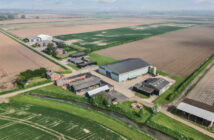Hutchinsons has established a new demonstration site at Cambourne, Cambridgeshire as a result of changing blackgrass emergence patterns.
It believes control strategies might need to be revised, which will be the focus of the new site. “Stale seedbeds and delayed drilling have been very effective measures for reducing September and early October-germinating blackgrass, but the weed is adapting to what we do,” explains Hutchinsons technical manager, Dick Neale.
“We are now seeing a significant shift towards later-germinating blackgrass populations in many situations, and evidence also suggests blackgrass is becoming more vigorous, producing far more tillers than in the past.”
On the 40ha site, hosted by the Clear family, these new dynamics are clearly evident. Despite using delayed drilling and stale seedbeds, the farm has been unable to achieve full control of the weed.
This is due to emergence becoming later and protracted – something highlighted by the wet conditions last autumn, which forced drilling to be pushed back to the spring.
“We tried various things before the weather broke last autumn, from different cultivations and cover crops, to no cover crops, or allowing volunteers to grow or not grow. Normally, these areas would have all gone under the drill by mid-October, but this season they didn’t; many areas had to be left undrilled, so continued through the winter,” says Dick.
“This showed the bulk of blackgrass we are dealing with on this farm, is germinating from the 20 October onwards, not in September or early October, and is doing so in combination with additional cultivations.”
Farmacy agronomist Tom Smith adds that individual blackgrass plants are noticeably more vigorous, with greater tillering capacity. Some plants on the site is producing up to 50 tillers per plant, around 50% more than the typical number a few years ago.
On the Cambourne site, the current blackgrass population is around 200-300 heads/sq m.
Whole-farm weed solutions
Delaying drilling further will not be viable on heavier land so the Hutchinsons team is looking at whole-farm solutions to tackle blackgrass.
Drainage has been singled out as a top priority on the Cambourne site, following the wet autumn and TerraMap analysis.
“We’ve seen a number of springs pop up in some fields over the winter, and many areas have really struggled with drainage on the heavy clay soil, so will clearly benefit from mole draining this autumn,” notes Farmacy agronomist, Poppy Clark. “The priority is to get the water moving through the soil and remove those wet patches.”
The analysis also showed that the silly clay soil is high in magnesium, creating a tighter structure that can be hard to work and will likely impair root growth and water infiltration.
To address this, one field received 3t/ha of gypsum last autumn. This will be an option the team will use again as gypsum is a relatively low-cost solution to these issues. Other options include multi-species cover crops to improve soil structure and break up tight layers to boost drainage.
Bringing the drilling date forward to the first week in October is also been considered to establish a competitive crop before the blackgrass flush.
Dick explains that this approach must be supported with a strong residual herbicide programme, with correct timings and limited applications at drilling.
“Drilling earlier may be possible and is something many growers might be keen to do this year, but you need to understand the dynamics of blackgrass and observe what’s happening in each field on your farm to ascertain when most of the population is emerging,” he says.
“If it is a late-emerging population, stale seedbeds and delayed drilling may not be working for you any longer, and there may well be a place for drilling earlier and being more focused with residual choices and timings.”
Spring cropping
Tom Smith notes that most of the land at Cambourne was sown with spring barley due to the difficulties last autumn, which helped reduce blackgrass pressure.
This is due to the weed having extra time to emerge before an application of glyphosate. The team also conducted trials including placement of fertiliser at drilling, seed rate variations and the use of spring beans as a companion crop.
Anecdotal evidence suggests that the crop sown with fertiliser was quicker to establish, increasing the likelihood of competing with the blackgrass. Avoiding whole field applications of fertiliser also avoided stimulating weed growth.
The seed rate trials also showed interesting results. Seed rates varied from 200 kg/ha (equivalent to 350 established plants/sq m) up to 275 kg/ha (530 plants/sq m), with higher rates offering much greater competition against blackgrass.
Tom notes that the highest spring barley seed rate, an average blackgrass population of 4 plants/sq m and 3 tillers per plant was recorded (ranging from 1 to 6 tillers). In contrast, at the lowest seed rate, there was an average of 20 plants/sq m and 16 tillers per plant (ranging from 3 to 20+).
“The majority of blackgrass was smaller with fewer tillers at the higher seed rates, but we need to strike a balance,” he says. “The spring barley was also more cramped in at higher rates, resulting in smaller plants and fewer tillers, so we need to find where the optimum is for both blackgrass control and crop yield potential.”
An interesting point was that the one area deliberately not treated with glyphosate before drilling saw 44 blackgrass plants/sq m, producing 20 tillers on average, although plants with more than 40 tillers were found.




